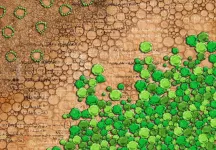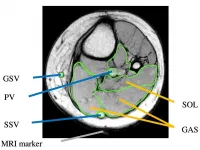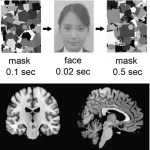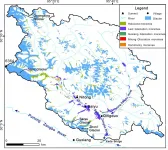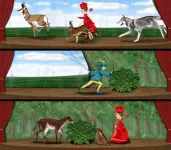(Press-News.org) A forest looks like a hotbed of randomness, with trees and plants scattered in wild and capricious diversity. But appearances can be deceiving, say a trio of complexity researchers at the Santa Fe Institute (SFI). Underneath that apparent messiness lurk extraordinary regularities, governed by the biological mechanisms that drive universal forces of growth, death, and competition.
In a paper published April 9 in the journal PNAS, the SFI group, led by Program Postdoctoral Fellow and now Complexity Science Hub Vienna Postdoctoral Scientist Eddie Lee, describes a new framework that can reproduce those spatial and temporal patterns that emerge in places and spaces where plants grow together. The framework uses computational and statistical tools to connect metabolic principles, which control how an individual organism lives and thrives, to the diverse arrangements of trees, shrubs, and other vegetation readily observed in landscapes, forests and beyond.
"This paper goes a long way in showing how things that look arbitrary and capricious can in fact be understood within a mathematical framework," says SFI Distinguished Shannan Professor and former President Geoffrey West, who collaborated with Lee and Chris Kempes, SFI Professor, on the model.
Scientists have long sought mathematical laws that connect the similar patterns that emerge at large and small scales of existence. "If you look at the microscopic structure of multicellular life, you see a lot of the same patterns playing out," says Lee. The metabolic rate of an organism follows a power scaling law with its mass, for example. Previous attempts at establishing such mathematical laws for the assemblage of plants in a forest have been a source of vociferous debate.
In previous work, West and others have developed models that start with the metabolic constraints on a single, optimized tree to make predictions about patterns that might emerge in a community of such trees. The model accurately showed how features like growth rate or canopy size might change with plant size -- and how those features might affect competition with other organisms or change the structure of the entire forest.
Kempes says that this idealized model paved the way for connecting biological principles like metabolism to mathematical, macro-level patterns, but over time researchers began to focus on how real-world situations differ in detail from that model. Not every tree or population follows the optimal rules, though, leading researchers like Lee to investigate new ways to generalize the core tenets.
"What happens when that law for scaling deviates for individual species, or for different contexts? How does that work?" says Kempes. "How do all those fit together?"
The new model extends essential ideas from earlier works for how to set up a model informed by the biological principles of growth, death, and resource competition, but it also allows a user to generalize those ideas to a wide range of species and situations, says Kempes. A user might relax certain assumptions about tree allometries -- relationships between size and shape -- or incorporate ideas about how trees interact with other organisms, like termites.
By turning these "knobs" on the simulation, Lee says, researchers can more closely reproduce the diverse ways that forests diverge from the idealized model. They can also clearly connect biological principles at the level of the organism to how forest structure plays out on larger scales.
West says the new approach will not only reveal scaling laws that have been previously gone unnoticed but also shine a light on new areas of investigation. "One of the great things about having an analytical model of this kind is that it points to where data is missing, or where data is poor," he says, "and the kinds of things people should be measuring."
The model also shows how a physics-inspired approach -- which often focuses on idealized situations -- can contribute to advances in understanding biological complexity. "There is this marvelous interplay between the fields," West says.
INFORMATION:
The internet seems like the place to go to get into fights. Whether they're with a family member or a complete stranger, these arguments have the potential to destroy important relationships and consume a lot of emotional energy.
Researchers at the University of Washington worked with almost 260 people to understand these disagreements and to develop potential design interventions that could make these discussions more productive and centered around relationship-building. The team published these findings this April in the latest issue of the Proceedings of the ACM in Human Computer Interaction Computer-Supported Cooperative Work.
"Despite the fact that online spaces are often described as toxic and polarizing, ...
Chronic lower-limb edema (CLE) -- the permanent accumulation of fluid in the leg -- often occurs in elderly people. The condition leads to various physical and mental problems, including difficulty in walking or moving, fatigue and anxiety. One cause of CLE is the lack of physical activity, which is associated with a decrease in muscle pump action. The latter refers to the leg muscle's acting as a blood pump: when contracted, the muscle squeezes veins together, forcing blood to flow. The question whether muscle pump action systematically changes with age has not been thoroughly investigated; now, Junko Sugama from Kanazawa University and colleagues have addressed this issue. In addition, they studied how leg posture affects muscle pump action.
For their study, Sugama ...
Osaka, Japan - As humans, we each have a powerful ability to easily recognize our own face. But now, researchers from Japan have uncovered new information about how our cognitive systems enable us to distinguish our own face from those of others, even when the information is presented subliminally.
In a study published this month in Cerebral Cortex, researchers from Osaka University have revealed that a central element of the dopamine reward pathway in the brain was activated when participants were subliminally shown images of their face. This provides new clues regarding the underlying processes of the brain involved in self-facial recognition.
When we are ...
Southeastern Tibet is one of the most glaciated regions on the Tibetan Plateau both at present and during the Quaternary. Numerical dating of glacial deposits has allowed the establishment of a provisional chronology of Quaternary glacial fluctuations in this region, with the oldest glaciation (Guxiang Glaciation) occurring in marine oxygen isotope stage 6 (MIS-6). However, glaciations predating MIS-6 have been identified at many locations on the Tibetan Plateau and its surrounding mountains, posing the question: as a major glaciation center both at present and during the Quaternary, did a glaciation prior to MIS-6 ever occur in southeastern Tibet?
Zhou et al. (2021) provide evidence for a glacier advance in the Bodui Zangbo River ...
Japan -- Next to cat videos, watching small and cuddly rabbits is probably one of the most popular internet pastimes. Plus they appear in literature as well as in traditional folklore spanning numerous cultures, thanks likely to the fact that rabbits reside on every continent except Antarctica.
Yet despite their ubiquity, lagomorphs -- including rabbits, hares, and pikas -- are rather limited in their size diversity. Compare this to their evolutionary sisters, the rodents, which vary in size from the four-gram pygmy mouse to capybaras weighing as much as 50 kilograms.
So why don't we see rabbits rivaling the sizes of horses?
To answer this question, a research team ...
With its more than 40 million articles in 301 different languages, Wikipedia is one of the largest human collaboration efforts in history. One of the main pillars on which this wish to bring together the sum of all knowledge is based is the achievement of a neutral space. However, several studies suggest that the site suffers from a persistent gender bias as regards both content and the composition of its community. An analysis of the gender gap in the Spanish-language version of Wikipedia by an interdisciplinary team at the UOC has revealed that only 11.6% of its registered editors are women.
According to the new study, which has been published in the journal PLOS ONE, the difference could be partially due to female editors being less ...
Over the last 200 years, researchers have worked towards understanding the global distribution of species and ecosystems. But so far even the basic knowledge on the global geography of genetic diversity was limited.
That now changes with a recent paper from Globe Institute. Professor David Nogues Bravo and his team has spent the last eight years combining data from scientific gene banks with scenarios of future climate and land-use change. The result is the first ever global assessment of how it will impact the genetic diversity of mammals, e.g. when tropical forests are converted to agricultural land.
'Our study ...
Singapore, 19 April, 2021 - Researchers at the Future Urban Mobility (FM) Interdisciplinary Research Group (IRG) at Singapore-MIT Alliance for Research and Technology (SMART), MIT's research enterprise in Singapore, have created a synthetic framework known as theory-based residual neural network (TB-ResNet), which combines discrete choice models (DCMs) and deep neural networks (DNNs), also known as deep learning, to improve individual decision-making analysis used in travel behaviour research.
In this research paper, Theory-based residual neural networks: A synergy of discrete choice models and deep neural networks, ...
The production of nanomaterials involves self-assembly processes of functionalized (organic) molecules on inorganic surfaces. This combination of organic and inorganic components is essential for applications in organic electronics and other areas of nanotechnology.
Until now, certain desired surface properties were often achieved on a trial-and-error basis. Molecules were chemically modified until the best result for the desired surface property was found. However, the processes controlling the self-assembly of molecules at interfaces are so complex ...
Liquid Crystals (LC) are widely deployed in display technology and optical fibres. From smartphones in your pockets to large screen TVs, LCs are everywhere, as this special state of matter has been found in colorful soap bubbles as well as certain living tissues.
But LCs are by no means limited to use in gadgets or electronic devices. For quite some time, scientists have been studying the possibility of creating "active nematics", a particular class of active LCs, which consist of self-driven units capable of converting chemical or other forms of energy into motion. When administered the proper stimuli, scientists have found that they can generate a predictable response from different LCs, which allows for design of smart, multifunctional ...
